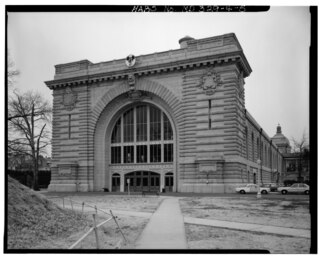
The NCAA Boxing Championship was discontinued by the National Collegiate Athletic Association after 1960. The popularity of college boxing peaked in 1948, when 55 colleges participated in intercollegiate competition. The popularity of college boxing had been waning in the years leading up to 1960, and only 20 teams competed at the 1959 championship. At the 1960 NCAA Championships Charlie Mohr, a boxer on the University of Wisconsin–Madison team, collapsed with a brain hemorrhage and died one week later.

The Pittsburgh Panthers, commonly also referred to as the Pitt Panthers, are the athletic teams representing the University of Pittsburgh, although the term is colloquially used to refer to other aspects of the university such as alumni, faculty, and students. Pitt fields 19 university-sponsored varsity teams at the highest level of competitive collegiate athletics in the United States: the NCAA Division I Football Bowl Subdivision (FBS) for American football.

The Penn State Nittany Lions are the athletic teams of Pennsylvania State University, except for the women's basketball team, known as the Lady Lions. The school colors are navy blue and white. The school mascot is the Nittany Lion. The intercollegiate athletics logo was commissioned in 1983.

Kai Wen "Kevin" Tan is an American artistic gymnast.
Tyler Mizoguchi is an American gymnast from the University of Illinois specializing in men's all around. He was an NCAA All-American for the 2010 and 2011 seasons and has a career high seven individual titles. In his freshman year, he placed first overall on the parallel bars at the Big Ten Championships. He has also placed second on the pommel horse and second in the all-around against Penn State.

The NCAA Division II Men's Gymnastics Championships were the annual collegiate gymnastics championships for men organised by the National Collegiate Athletic Association for athletes competing at universities in Division II. The championship was founded in 1968, breaking away from the championship for Division I, but ceased after the 1984 championship when it was merged back into one single national championship again.
The 2014 NCAA Men's Gymnastics Championships was a three-day event which determined the 2014 National Champion in Men's Gymnastics. The event took place from April 10 to April 12, 2014, at the Crisler Center in Ann Arbor, Michigan, United States, as it was hosted by the University of Michigan.
The 1975 NCAA Division I Men's Cross Country Championships were the 37th annual cross country meet to determine the team and individual national champions of NCAA Division I men's collegiate cross country running in the United States. Held on November 24, 1975, the meet was hosted by Penn State University at the Penn State Golf Courses in State College, Pennsylvania. The distance for this race was 6 miles. This was the final national meet at this distance.
The 1984 NCAA Division I Cross Country Championships were the 46th annual NCAA Men's Division I Cross Country Championship and the 4th annual NCAA Women's Division I Cross Country Championship to determine the team and individual national champions of NCAA Division I men's and women's collegiate cross country running in the United States. In all, four different titles were contested: men's and women's individual and team championships.
The 2015 NCAA Division I Cross Country Championships were the 77th NCAA Men's Division I Cross Country Championship and the 35th NCAA Women's Division I Cross Country Championship to determine the national champions of men's and women's NCAA Division I collegiate cross country running. It was held at E. P. "Tom" Sawyer State Park in Louisville, Kentucky and was hosted by the University of Louisville on November 21, 2015. Four different championships were contested: men's and women's individual and team championships.
The 2021 NCAA Men's Gymnastics Championships were held from April 16-17, 2021 at the Maturi Pavilion in Minneapolis, Minnesota. Both of the qualifying sessions were broadcast live on Big Ten Network+, while the championship finals were televised live on Big Ten Network.

Stephen Nedoroscik is an American artistic gymnast who specializes on the pommel horse. He is the 2021 World Champion and a two-time NCAA National Champion on the event. He is a member of the United States men's national gymnastics team.
The 2022 NCAA Men's Gymnastics Championships was held from April 15–16, 2022 at the Lloyd Noble Center in Norman, Oklahoma.
The 2019 NCAA Men's Gymnastics Championships were held from April 19–20, 2019 at the State Farm Center in Champaign, Illinois.

The 1942 NCAA gymnastics championships were contested at the fifth annual National Collegiate Athletic Association-sanctioned men's gymnastics championships to determine the team and individual national champions of men's collegiate gymnastics among its member programs in the United States.

The 1948 NCAA gymnastics championships were contested at the sixth annual National Collegiate Athletic Association-sanctioned men's gymnastics championships to determine the team and individual national champions of men's collegiate gymnastics among its member programs in the United States. Due to the interruption of sporting events caused by World War II, these were the first championships held since 1942.

The 1949 NCAA gymnastics championships were contested at the seventh annual National Collegiate Athletic Association-sanctioned men's gymnastics championships to determine the team and individual national champions of men's collegiate gymnastics among its member programs in the United States.
The 1952 NCAA gymnastics championships were contested at the 10th annual NCAA-sanctioned gymnastics meet to determine the team and individual national champions of men's collegiate gymnastics among its member programs in the United States.







